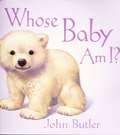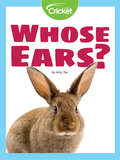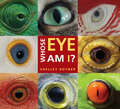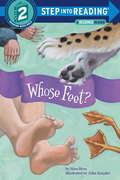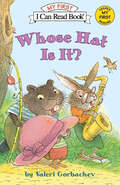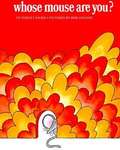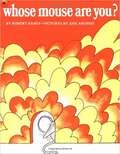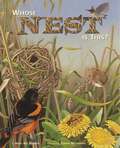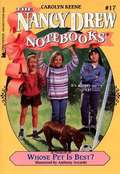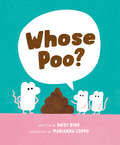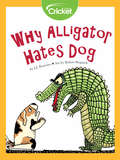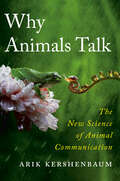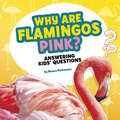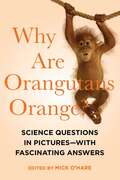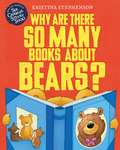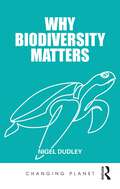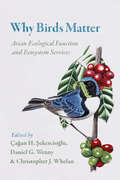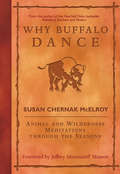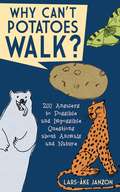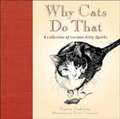- Table View
- List View
Whose Baby Am I?
by John ButlerA question and answer book first showing a baby animal and then answering with the baby and its mother on the page following.
Whose Ears?
by Amy TaoAnimals have different-looking ears, yet, help them to hear! Some animals have large floppy ears like the bunny, who points each ear in different directions–hearing two sounds at once! The harbor seal that has no ears, yet hears through holes that close when it dives! Whether floppy or unnoticed–these animals have ears perfect for hearing!
Whose Egg Is That? (Whose Is THAT?)
by Darrin LundeA nonfiction guessing game that explores the connections between an animal, its eggs, and its habitat.Written by a mammalogist at the Smithsonian, this clever preschool page-turner pairs seven eggs with information about the animals' survival mechanisms, asking kids to guess which animal laid which egg. Whose Egg Is That? reveals the animals--ranging from penguins to platypuses--in their own habitats.
Whose Eye Am I?
by Shelley Rotner"Who am I?" ask captions alongside close-ups of colorful animal eyes. As readers guess which animal belongs to each eye, they will discover that each animal has a unique and amazing way of seeing. Snakes have clear eyelids that cannot ever open or close. Some sea creatures have hundreds of eyes around the edges of their shells. Many animals can see colors that are invisible to humans. Brimming with vivid and engaging photographs, this book also includes a clear explanation of how human eyes work, a labeled diagram of a human eye, a glossary, and an index.
Whose Feet? (Step into Reading)
by John Kanzler Nina HessMole claws scrape out a new home. A duck uses her webbed feet to flip underwater and search for a snack. Orangutan feet grab on tight as they swing from vine to vine. Who knew that feet could be so special and perform such extraordinary feats!
Whose Footprint Is That? (Whose Is THAT?)
by Darrin LundeA nonfiction guessing game that explores the connections between an animal, its tracks, and its habitat.Written by a mammalogist at the Smithsonian, this clever preschool page-turner pairs seven tracks with information about the animals' locomotion, asking kids to guess which animal left which tracks behind. Whose Footprint Is That? reveals the animals--ranging from flamingos to kangaroos--in their own habitats.
Whose Hat Is It? (My First I Can Read)
by Valeri GorbachevWhen a little turtle comes across a lost hat, he is determined to find its owner. He asks Mouse, and Rabbit, and even Crocodile if it belongs to them, but they all say it isn't theirs. Whose hat can it be?
Whose Mouse Are You?
by Robert KrausA lonely little mouse has to be resourceful in order to bring his family back together.
Whose Mouse are You? (Fountas & Pinnell LLI Blue #Level H)
by Robert KrausA lonely little mouse has to be resourceful in order to bring his family back together.
Whose Nest Is This?
by Roermer Mclennan"Springtime is here. There is work to be done, as animal parents make nests for their young. Using pebbles, or woodchips, even mud, spit, and leaves-many creatures make nests…Whose nests are these?" So begins this spirited, rhyming, picture book that describes in riddle-form the many types of nests animals make, from the tiny ruby-throated hummingbird to the imposing sea turtle. "There are mammals and reptiles and insects who nest. Birds, too, build unique nests that suit them the best. Some nests provide shelter, and some are for show, but the best nests are those in which young babies grow!"
Whose Pet Is Best? (The Nancy Drew Notebooks #17)
by Carolyn KeeneWHAT'S ON TV? IS IT NANCY DREW? It's the Amazing Pet Contest, and the winner gets to go on Mr. Lizard's Funhouse . . . on TV! Katie's got a singing parrot. David's got a gross rat. And Nancy's got Chocolate Chip, her soccer-playing puppy. . . . But Chip won't do her trick. Something's wrong, and Nancy's afraid she's sick. She also thinks it just wouldn't be fair if Chip doesn't get to go on TV because somebody played a dirty trick on her!
Whose Poo?
by Daisy BirdFor fans of Everyone Poops, a hilariously fresh take on POO! A trip to the zoo turns into a very silly discussion about poo, as two siblings wonder what sort of poo each and every creature would do.One day, Daddy Rat announces to his baby rats that he'll be taking them to the zoo . . . but only if they're good, which means no talking about poo! And yet, before the family can even leave the house, the two rascally siblings can't help but wonder . . . what sort of poo would an astronaut do? Shiny, silver, space-age poo! Rocket-powered, weightless poo, and it spins round and round like a planet does, too! Head chefs, balloon sellers, blue whales . . . everyone and everything must have a unique poo, and the siblings simply have to stop and imagine each and every one (much to the chagrin of Daddy Rat, who is getting increasingly irritated with all the poo talk). Once the rats finally reach the zoo, things escalate, because of course each and every animal in the zoo must do a special kind of poo! Finally, Daddy Rat has simply had enough, and is forced to sit down and explain the facts to his curious kids. And when he thinks he may have gotten through to his youngsters, he encounters a surprising (and smelly) twist which will have little rats everywhere laughing out loud!
Whose Poop Is That? (Whose Is THAT?)
by Darrin LundePoop! Ewwww!No, don&’t say &“Ewwww.&” Ask, &“Whose poop is that?&” This simple, and yes, charming book asks this question about seven examples of animal poop. By investigating visual clues, young readers can learn to identify the animal through its droppings. For instance, find a sample of poop with bits of bone and tufts of hair. Turn the page to learn it came from a fox! Kelsey Oseid&’s illustrations are both accurate and beautiful. Backmatter includes further information about the poop and what scientists can learn from an animal&’s droppings."A primer on poop and a guessing game, especially for those just beyond toilet training" — Kirkus Reviews"Gross-out details will provoke glee...but kids will learn plenty about the variety and importance of animal waste, too" —Publisher's Weekly"As accessible to newly independent readers as it is to younger listeners" — Bulletin of the Center for Children's Books"Sure to appeal to curious youngsters. Recommended for collections that can't get enough titles on poop" — School Library Journal"The kid-friendly illustrations and matter-of-fact tone make this title an informative, rather than a gross-out, pick, though is certainly what will get kids reaching for the shelves" — Booklist"Friendly and inviting to novice naturalists" — Horn Book"What are you waiting for? Come get the &“scoop on poop&”!" — NSTA Recommends
Whose Tracks Are These?: A Clue Book of Familiar Forest Animals
by James NailA series of clues and striking illustrations detail how to identify a variety of pawprints found in the woodlands.Ages 6-10
Why Alligator Hates Dog
by J. J. ReneauxEveryone respects M'su Cocodrie, the king of the swamp, except the dogs, who taunt him and make lots of noise. M'su Cocodrie wants to teach them a lesson, but the tables are turned and it is M'su Cocodrie who learns a lesson.
Why Animals Talk: The New Science of Animal Communication
by Arik Kershenbaum"Animal communication doesn&’t need to resemble human language to be full of meaning and nuance. Arik Kershenbaum delivers an expert overview of the astonishing discoveries made in the last few decades" —Frans de WaalFrom leading zoologist Arik Kershenbaum, a delightful and groundbreaking exploration of animal communication and its true meaningAnimal communication has forever seemed intelligible. We are surrounded by animals and the cacophony of sounds that they make—from the chirping of songbirds to the growls of lions on the savanna—but we have yet to fully understand why animals communicate the way they do. What are they saying? This is only part of the mystery. To go deeper, we must also ask, what is motivating them?Why Animals Talk is an exhilarating journey through the untamed world of animal communication. Following his international bestseller, The Zoologist&’s Guide to the Galaxy, acclaimed zoologist Arik Kershenbaum draws on extensive original research to reveal how many of the animal kingdom&’s most seemingly confusing or untranslatable signals are in fact logical and consistent—and not that different from our own. His fascinating deep dive into this timeless subject overturns decades of conventional wisdom, inviting readers to experience for the first time communication through the minds of animals themselves.From the majestic howls of wolves and the enchanting chatter of parrots to the melodic clicks of dolphins and the spirited grunts of chimpanzees, these often strange expressions are far from mere noise. In fact, they hold secrets that we are just beginning to decipher. It&’s one of the oldest mysteries that has haunted Homo sapiens for hundreds of thousands of years: Are animals talking just like us, or are we the only animals on the planet to have our own language?
Why Are Flamingos Pink?: Answering Kids' Questions (Questions and Answers About Animals)
by Nancy DickmannThe world is full of colorful birds. But why are flamingos bright pink? You have questions and this book has answers. Find out about flamingos, including what they eat and their behavior.
Why Are Orangutans Orange?
by Mick O’HareFun science and nature trivia with full-color photos in a &“deeply fascinating and occasionally rib-tickling book&” (Booklist).From the editor at New Scientist who brought us such works as How to Fossilize Your Hamster, this is an illustrated compendium of facts that reveal the beauty, complexity, and mystery of the world around us. Drawing on the magazine&’s popular &“Last Word&” column, Why Are Orangutans Orange? covers everything from bubbles to bugs, as well as why tigers have stripes and blue-footed boobies have, well, blue feet. With over two million copies sold, this series of question-and-answer compendiums is a delight for anyone who loves to learn!
Why Are there So Many Books About Bears?
by Kristina StephensonHave you ever wondered why there are so many books about bears? That is the Impossible Question that all the other animals just can't figure out! Thankfully the most brilliant minds in the animal kingdom have gathered to try and answer it, once and for all. But someone keeps knockety-knocking on the door, offering tea and cakes and interrupting their train of thought! Maybe the answer they're looking for was right outside all along...From the brilliant author of Sir Charlie Stinky Socks, this hilarious picture book has a very cute surprise in store!
Why Bear Sleeps All Winter (Leveled Readers)
by Sharon FearThis is a tale that tells a make-believe reason for why bears sleep all winter.
Why Biodiversity Matters (Changing Planet)
by Nigel DudleyAll life on Earth has the right to exist, but as we teeter on the verge of a sixth extinction this book discusses why biodiversity matters and why we should care if species go extinct. We are witnessing the largest and fastest rate of extinction in the history of the planet. While the concept of rights is a human one, all plants and animals strive to survive, and this book argues for their rights to continue doing so without being driven into premature extinction by human actions. Acknowledging and describing the practical reasons for conserving biodiversity, this book argues that these should not overshadow the compelling ethical reasons to care about the future of species other than our own. However, the issues are complex. What do we do when faced with an immediate ethical choice where biodiversity rights, animal rights, human rights, economic development and ecosystem survival all get mixed up together? There are seldom hard and fast answers, but thinking about and understanding a variety of points of view will help us make informed trade-offs. Drawing on his vast practical experience, the author presents insightful perspectives and real-world examples with the hope that this book will instigate a much-needed rethink about why and how we practise conservation. This book is essential reading for all those concerned with sustaining our planet, and all who inhabit it, in the face of climate breakdown, biodiversity loss and ecological collapse.
Why Birds Matter: Avian Ecological Function and Ecosystem Services
by Christopher J. Whelan Daniel G. Wenny Çağan H. Şekercioğlu, Daniel G. Wenny, and Christopher J. WhelanFor over one hundred years, ornithologists and amateur birders have jointly campaigned for the conservation of bird species, documenting not only birds’ beauty and extraordinary diversity, but also their importance to ecosystems worldwide. But while these avian enthusiasts have noted that birds eat fruit, carrion, and pests; spread seed and fertilizer; and pollinate plants, among other services, they have rarely asked what birds are worth in economic terms. In Why Birds Matter, an international collection of ornithologists, botanists, ecologists, conservation biologists, and environmental economists seeks to quantify avian ecosystem services—the myriad benefits that birds provide to humans. The first book to approach ecosystem services from an ornithological perspective, Why Birds Matter asks what economic value we can ascribe to those services, if any, and how this value should inform conservation. Chapters explore the role of birds in such important ecological dynamics as scavenging, nutrient cycling, food chains, and plant-animal interactions—all seen through the lens of human well-being—to show that quantifying avian ecosystem services is crucial when formulating contemporary conservation strategies. Both elucidating challenges and providing examples of specific ecosystem valuations and guidance for calculation, the contributors propose that in order to advance avian conservation, we need to appeal not only to hearts and minds, but also to wallets.
Why Buffalo Dance
by Susan Chernak McelroyIn this elegantly written and illustrated book, bestselling author Susan Chernak McElroy has gathered the voices of the wind, weather, animals, and elements and transcribed the he truths they have to share. Badgers and bison, magpies and moose, eagles and elk, all have wisdom teachings that shed light on our common journey through life.
Why Can't Potatoes Walk?: 200 Answers to Possible and Impossible Questions about Animals and Nature
by Lars-Åke Janzon Lukas MöllerstenWhen it comes to animals and nature, there is no end to our curiosity. Around ten thousand questions a year land on Lars-Åke Janzon's desk at the Swedish Museum of Natural History. In this sequel to the successful book How Long Can a Fly Fly?, Janzon responds to nutty questions, freak happenings, and odd observations with interesting facts and explanations. Learn about snake sex, animals' brightly colored warning signals, and why a vulture was arrested in Saudi Arabia on suspicion of being an Israeli spy. Find out the facts behind the headlines about Thailand's poisonous jellyfish and the "killer sharks" of Sharm el-Sheikh. For over ten years, Janzon has been researching the answers to questions like: What color will a chameleon turn if it lies on a chessboard? Why are flounders flat? How do sea urchins make love? How did wolves become big and bad? Why do animals migrate across Africa? Which animal has the longest tongue? Do fish spit?In addition to answering these and many other questions, Janzon breaks down scientific terminology, lists animal stats, debunks myths, and answers all sorts of did-you-knows you never even thought to ask about nature and evolution.Written with warm humor and educational zeal and accompanied by Lukas Möllersten's imaginative illustrations, this fun and educational book is perfect for all ages of readers with a casual interest in understanding just a little bit more about nature.
Why Cats Do That
by Karen AndersonWHY DO CATS PURR? WHY DO CATS GET stuck in trees? Why do they bring us their latest catch? Why do cats always land on their feet? Learn the fascinating and sometimes surprising facts about these and 36 other curious cat behaviors - light-heartedly explained and beautifully illustrated in this book. Author Karen Anderson and illustrator Wendy Christensen are both sincere cat-lovers whose admiration and devotion to their feline companions are sure to strike a chord with everyone who has a cat (or many cats!) in their midst. Illustrations are described by the scanner.
